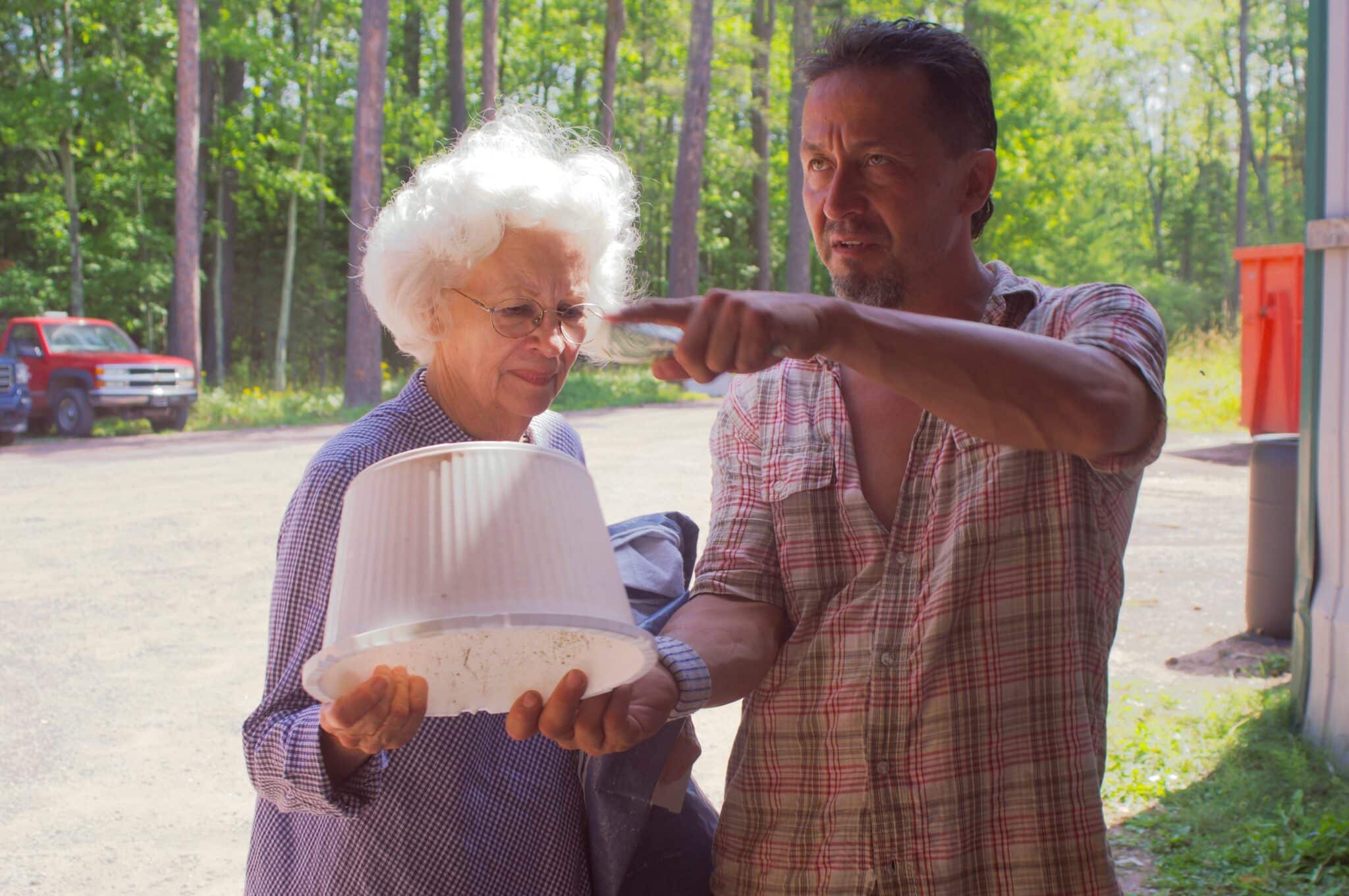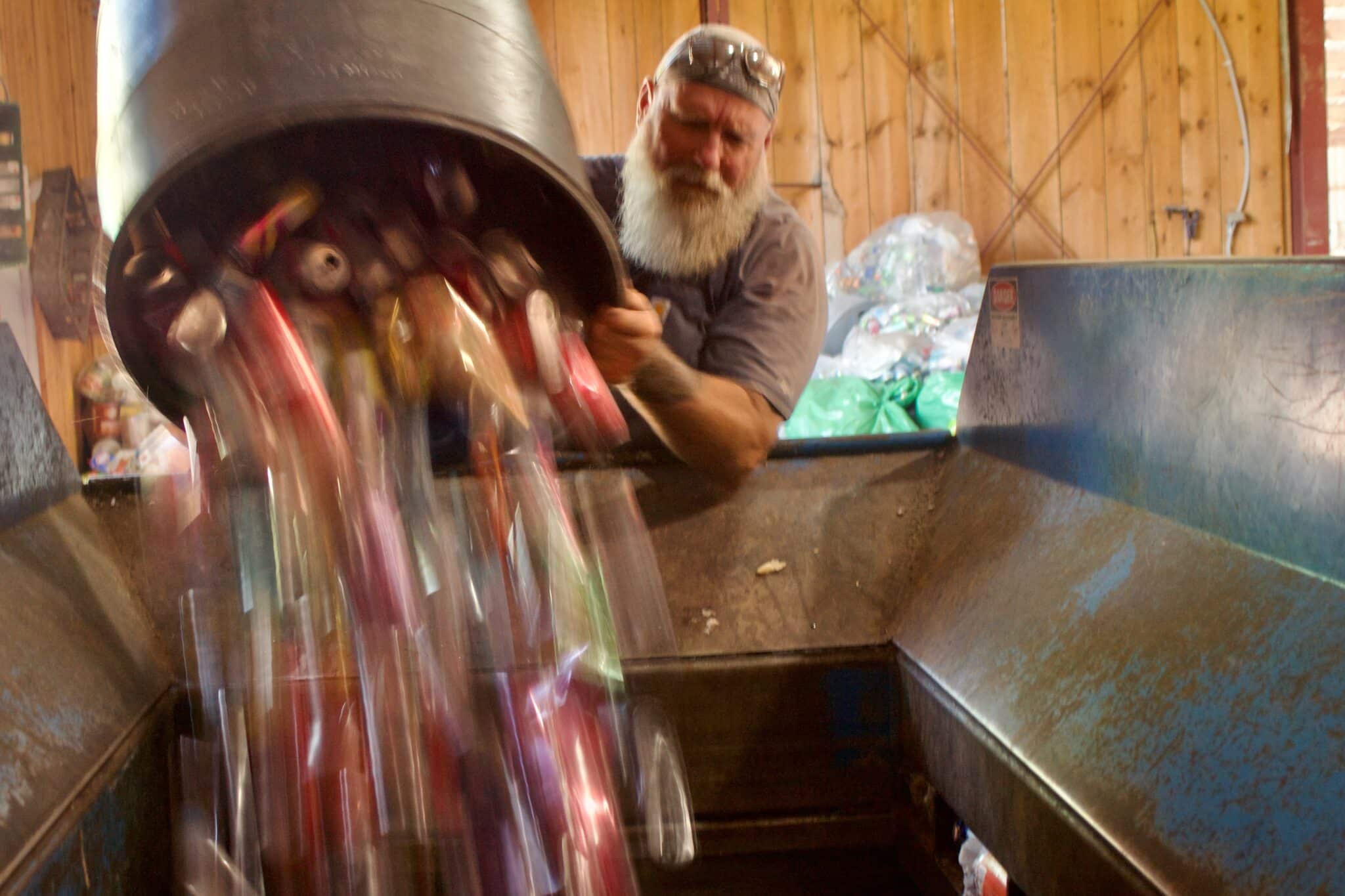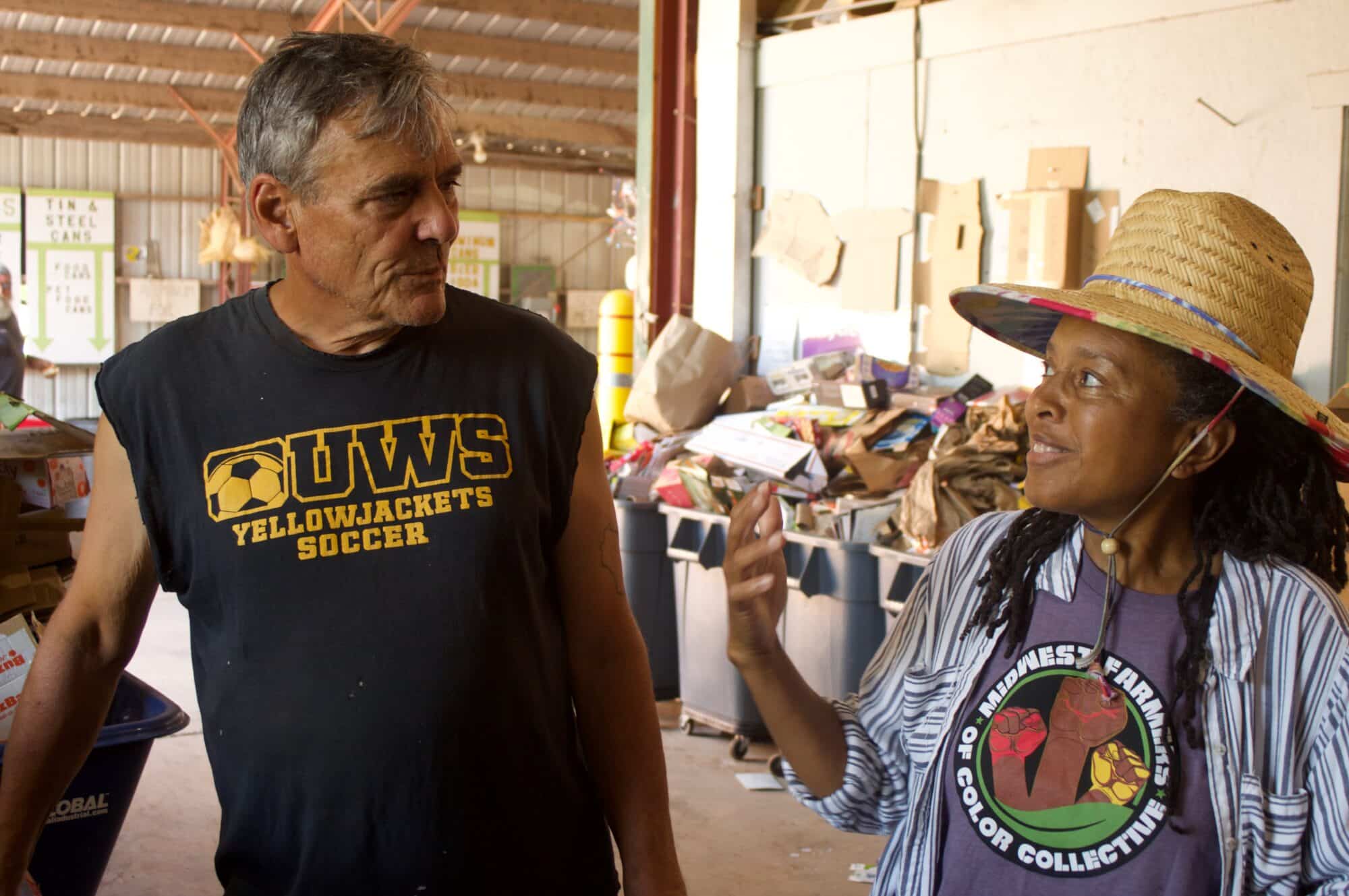This story was originally published by Barn Raiser, your independent source for rural and small town news.
On Lake Superior’s Madeline Island, an unexpected place has become a nexus for building community and planning an ecologically sustainable future: the town dump.
On a Saturday in late August, a steady stream of cars fills the drive-through of the Madeline Island Materials Recovery Facility (MRF, pronounced “Murf”).
Customers hop out to place sorted recycling in blue labeled bins, empty their compost, throw their trash bags in the trash compactor and get their dump cards—the method of payment at the dump—punched by one of two employees on duty.
Mimi Heersema-Smith, 72, begins her trash errand by jumping out of her car and hugging Marty Curry, the MRF Director. “I’ve been coming here since the 1950s, and this place has never been run as efficiently and enjoyably as it is now,” she says.
She refers to the clear signage directing island residents how to discard their waste, the neat bales of crushed cardboard and aluminum or to the small polka band playing across the gravel drive at the Island Closet, a second-hand store where discarded items find a second life. Many customers, after finishing their trash and recycling drop offs, bring their hand-me-downs and household items to the Island Closet, while scavenging for new treasures to bring home, setting a price of their choice. On a regular basis, people of all ages, from octogenarians, teenagers to toddlers can be seen browsing the store’s converted garage for a hodge-podge of treasures that would otherwise go to a landfill: quilts, furniture, tin jugs, neon baseball hats, rice cookers, puzzles, island memorabilia and mid-century lamps.

The Madeline Island MRF takes a novel approach to trash in a nation rife with the ills of overconsumption and perpetual waste mis-management. The amount of trash each person in the United States generates each day has more than doubled since 1960, from 2.7 lbs to 4.9 lbs—and we’re running out of space to hold it. By one industry estimate, landfill capacity in the Midwest will reach capacity as soon as 2033.
Landfill space has already run out here on Madeline Island, a 14- by 3-mile piece of the Northwoods that is one of the Apostle Islands, an archipelago on Lake Superior’s southern shore. The island’s population can fluctuate between 350 in the winter to over 2,500 in the summer vacation months. Most waste management systems aim to keep trash out of sight and out of mind. Here, because each piece of trash must be shipped to the mainland by ferry boat, Curry seeks to do the opposite. He wants to make waste management “an interactive process,” and one “where people start taking notice of exactly what it is they’re producing.”
The Madeline Island MRF is one of Wisconsin’s few remaining municipally owned and managed MRFs. In the United States, four out of five MRFs are now owned and operated by corporations like Waste Management, a trend that reduced budget pressure on local governments but does little to reduce waste.
In the long run, landfills work against long-term ecological sustainability. That’s why waste reduction is a core goal of the Madeline Island MRF, according to Glenn Carlson, Town Board Chair of La Pointe, Wisconsin, the island town. “The municipality has an interest in reducing the amount of business that the MRF gets. The more we can divert out of the waste stream, the better for the town and residents. A business in waste management would not be as interested in people reducing waste.”
In 2020, La Pointe’s MRF Working Group set a plan to make the facility a “learning laboratory” for educating the community about sustainability and waste on the island. A 2020 survey conducted by the Center for Rural Communities at Northland College in Ashland,Wisconsin, revealed that island residents see environmental sustainability as a core component of the island’s identity.
When Curry began working at the MRF in 2020 it was $200,000 in the red. It’s not surprising: establishing a profitable MRF has become increasingly challenging, which is one reason why so many have become privatized. Over the past two years, Curry and his team have managed to reduce the MRF’s losses to $70,000 per year.
MIMI HEERSEMA-SMITH“I’ve been coming here since the 1950s, and this place has never been run as efficiently and enjoyably as it is now.”

Municipal ownership doesn’t mean that Curry and team are lacking in business savvy. Curry and Michael Haben, the MRF’s materials recovery transportation specialist, play the fluctuating market of recyclables. When prices are low for materials like aluminum and cardboard, the MRF stores the materials; when it goes up, Haben trucks them over to the mainland for resale.
For customers, disposing of a bag of trash costs between $3 and $12, depending on size, while recycling plastic, cardboard, glass and aluminum is free. Curry says aluminum, the MRF’s leading revenue driver, is particularly valuable due to constraints and inefficiencies in the global market. About 6% of virgin aluminum is sourced from Russia, bearing high transportation and carbon emissions—this amid global supply chain disruptions and material shortages.
There are ecological benefits, too. According to the Wisconsin Department of Natural Resources, “Recycling one ton of aluminum saves the energy equivalent of 2,350 gallons of gasoline or the total amount of electricity used by a typical Wisconsin home over 10 years.”
On Saturday, Curry and Haben buzz about the facility as the flow of cars picks up, answering questions about how and where to recycle odd household items like metal light fixtures and PVC pipe. Curry asks nearly every customer if they’re attending the Polka Ball at the Town Fire Hall that weekend. “I’ve seen 80-year-old ladies polka-ing while they recycle,” he says with a chuckle.
Regular MRF customers bring pre-paid punch cards to mark the size of each garbage bag, facilitating a quick check-out at the register, where Curry keeps a tray of foil-wrapped chocolates and a box of dog treats for canine friends. On a corkboard by the door are photos of the MRF team going back decades.

In the cavernous shed where large recyclables are stored, Regina Laroche, a farmer on the island, sorts through stacks of cardboard that she and her husband Jeff Theune use to line their vegetable beds to deter weeds. She says Curry often sets aside the best pieces of cardboard for her, along with lumber for their construction projects. “We built a chicken coop and basically everything for it was destined for that dumpster over there,” says Jeff.
Across a gravel drive at the Island Closet, a two-person polka band previews the weekend festivities.
Gwen Smith Patterson manages the Island Closet with a team of 20 volunteers, ranging from ages 8 to 92. Her team helps sort through donations and check out patrons at the door, welcoming—though not requiring—a cash donation in exchange. Donations support operating costs at the Island Closet and contribute to St. John’s United Church of Christ, the Closet’s proprietor. About 50 people visit per operating day—Monday, Wednesday, and Saturday each week throughout the summer.
“It’s as simple as reduce, reuse, recycle, rethink,” says Smith Patterson. In addition to diverting tons of waste from landfills, she says the Island Closet “brings new life to people and to things. It’s just rejuvenating.” Initiatives like the Island Closet were among the Wisconsin Department of National Resources’ reasons for awarding the Madeline Island MRF a 2022 Wisconsin Recycling Excellence Award.
This year, community members funded a pilot composting program to divert food waste from landfills. Curry says the compost will likely be raffled off or donated to the La Pointe Elementary School or Madeline Island Community Garden. So far, islanders have diverted 400 gallons of waste to compost, and Curry hopes to include restaurants, a significant source of food waste on the island, next year.
By the MRF exit, a low hill serves as a reminder of what’s at stake: it’s the Island’s old landfill, now capped with clay and covered by a thin layer of grass. As Curry describes it, “people would just drive up, dump their trash in and light it on fire.” Beneath the mound sits a layer of toxic sludge. Perhaps for the folks pictured on the bulletin board, this was all they knew of waste management.
Nowadays, Curry envisions digging out the old landfill and safely removing the waste to the mainland—and perhaps, one day soon, cultivating a wetland.
